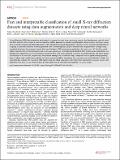| dc.contributor.author | Oviedo, Felipe | |
| dc.contributor.author | Ren, Zekun | |
| dc.contributor.author | Sun, Shijing | |
| dc.contributor.author | Settens, Charles M | |
| dc.contributor.author | Liu, Zhe | |
| dc.contributor.author | Hartono, Noor Titan Putri | |
| dc.contributor.author | Ramasamy, Savitha | |
| dc.contributor.author | DeCost, Brian L | |
| dc.contributor.author | Tian, Siyu IP | |
| dc.contributor.author | Romano, Giuseppe | |
| dc.contributor.author | Kusne, Aaron Gilad | |
| dc.contributor.author | Buonassisi, Tonio | |
| dc.date.accessioned | 2022-06-30T15:46:08Z | |
| dc.date.available | 2021-10-27T20:34:12Z | |
| dc.date.available | 2022-06-30T15:46:08Z | |
| dc.date.issued | 2019 | |
| dc.identifier.uri | https://hdl.handle.net/1721.1/136192.2 | |
| dc.description.abstract | © 2019, The Author(s). X-ray diffraction (XRD) data acquisition and analysis is among the most time-consuming steps in the development cycle of novel thin-film materials. We propose a machine learning-enabled approach to predict crystallographic dimensionality and space group from a limited number of thin-film XRD patterns. We overcome the scarce data problem intrinsic to novel materials development by coupling a supervised machine learning approach with a model-agnostic, physics-informed data augmentation strategy using simulated data from the Inorganic Crystal Structure Database (ICSD) and experimental data. As a test case, 115 thin-film metal-halides spanning three dimensionalities and seven space groups are synthesized and classified. After testing various algorithms, we develop and implement an all convolutional neural network, with cross-validated accuracies for dimensionality and space group classification of 93 and 89%, respectively. We propose average class activation maps, computed from a global average pooling layer, to allow high model interpretability by human experimentalists, elucidating the root causes of misclassification. Finally, we systematically evaluate the maximum XRD pattern step size (data acquisition rate) before loss of predictive accuracy occurs, and determine it to be 0.16° 2θ, which enables an XRD pattern to be obtained and classified in 5.5 min or less. | en_US |
| dc.language.iso | en | |
| dc.publisher | Springer Science and Business Media LLC | en_US |
| dc.relation.isversionof | 10.1038/S41524-019-0196-X | en_US |
| dc.rights | Creative Commons Attribution 4.0 International license | en_US |
| dc.rights.uri | https://creativecommons.org/licenses/by/4.0/ | en_US |
| dc.source | Nature | en_US |
| dc.title | Fast and interpretable classification of small X-ray diffraction datasets using data augmentation and deep neural networks | en_US |
| dc.type | Article | en_US |
| dc.contributor.department | Singapore-MIT Alliance in Research and Technology (SMART) | en_US |
| dc.contributor.department | Massachusetts Institute of Technology. Photovoltaic Research Laboratory | en_US |
| dc.contributor.department | MIT Materials Research Laboratory | en_US |
| dc.contributor.department | Massachusetts Institute of Technology. Department of Mechanical Engineering | en_US |
| dc.contributor.department | Massachusetts Institute of Technology. Institute for Soldier Nanotechnologies | en_US |
| dc.relation.journal | npj Computational Materials | en_US |
| dc.eprint.version | Final published version | en_US |
| dc.type.uri | http://purl.org/eprint/type/JournalArticle | en_US |
| eprint.status | http://purl.org/eprint/status/PeerReviewed | en_US |
| dc.date.updated | 2020-06-24T19:22:08Z | |
| dspace.orderedauthors | Oviedo, F; Ren, Z; Sun, S; Settens, C; Liu, Z; Hartono, NTP; Ramasamy, S; DeCost, BL; Tian, SIP; Romano, G; Gilad Kusne, A; Buonassisi, T | en_US |
| dspace.date.submission | 2020-06-24T19:22:10Z | |
| mit.journal.volume | 5 | en_US |
| mit.journal.issue | 1 | en_US |
| mit.license | PUBLISHER_CC | |
| mit.metadata.status | Publication Information Needed | en_US |
